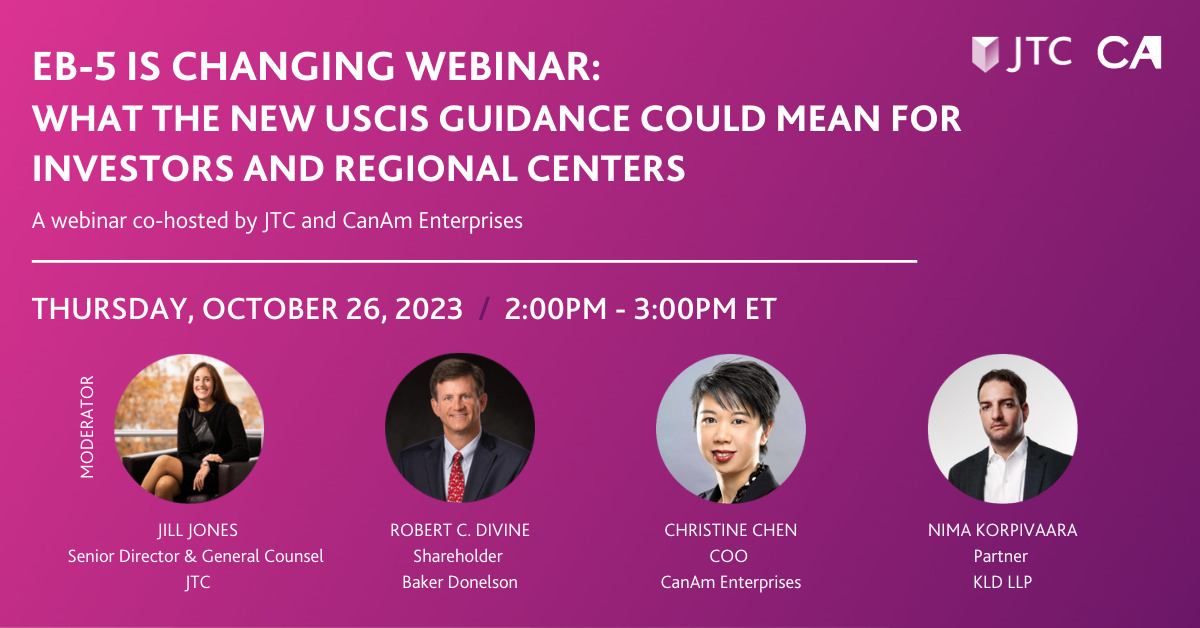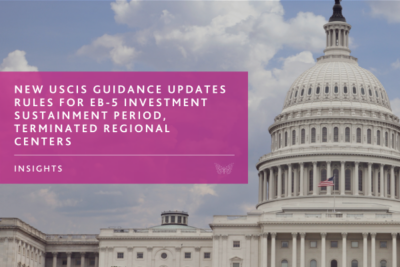Visa Bulletin Update Series | Part 1
In the dynamic world of EB-5 immigration, timing is everything. And for thousands of investors closely watching the U.S. Visa Bulletin, a single line of text can cause ripple effects that alter strategy, impact outcomes, and stir uncertainty. That’s exactly what happened in January 2025, when a footnote in the Visa Bulletin signaled the possibility of near-term retrogression for EB-5 reserved visa categories—sending shockwaves through the investment community.
In this multi-part series, we break down the latest insights from CanAm’s most recent EB-5 Visa Bulletin webinar, moderated by Pete Calabrese (CEO, CanAm Investor Services) and featuring two of the industry’s foremost experts: Charlie Oppenheim, former Chief of Immigrant Visa Control at the U.S. Department of State, and Joey Barnett, Partner at WR Immigration.
This first installment focuses on the moment that reignited investor anxiety—the now-infamous January 2025 footnote—and how subsequent developments have revealed both the value and the limits of that warning.
Rewinding the Clock: The Footnote That Shook the Industry
Back in December 2024, the Department of State released the January 2025 Visa Bulletin with a new footnote that raised more questions than answers. The footnote indicated that, due to rising demand, final action dates might soon be established for the EB-5 reserved visa categories—rural, high-unemployment, and infrastructure.
For investors and industry professionals, it was a warning shot. Would the opportunity to concurrently file for adjustment of status suddenly disappear? Would EB-5 applicants once again face multi-year wait times?
As Joey Barnett recalled, “It really started people’s conversations about, well, what are we looking at here in the very near future? Is this something that we need to prepare for right away?”
At the time, there was no mention of the unreserved visa categories, but anxiety spilled over nonetheless. The prospect of lost opportunity led to a surge in investor inquiries, legal consultations, and concerns about how quickly doors might close.
Parsing the Footnote: What It Actually Meant
Looking back with the benefit of hindsight—and updated government data—our expert panel agrees: the footnote was premature.
Charlie Oppenheim, who led the Visa Control Office at the State Department for over two decades, stated it plainly:
“I think they were premature in posting this note in the bulletin, and that it caused unnecessary concern in the reserved community.”
He emphasized that while the warning was directionally accurate—acknowledging that reserved demand would eventually grow—it overstated the urgency. The underlying data simply didn’t justify triggering investor alarm at that stage.
The Reality: Reserved Categories Are Still Current
As of the June 2025 Visa Bulletin, the picture is clear: all EB-5 reserved visa categories remain current.
This includes:
- Rural projects (20% of EB-5 visa allocation)
- High-unemployment projects (10%)
- Infrastructure projects (2%)
Why? Because although filings have increased in these categories since the EB-5 Reform and Integrity Act took effect, USCIS has not yet adjudicated enough I-526E petitions to create actual visa demand pressure.
As Barnett explained:
“They aren’t adjudicating enough of these set-aside I-526Es to generate enough demand to exceed the actual supply or the limits. And because of that… those categories remain current today.”
So while the footnote correctly signaled the long-term trend, it got the timeline wrong. The reserve categories may eventually require final action dates—but not yet. The underlying mechanism that triggers retrogression simply isn’t in motion.
The Misplaced Spillover of Concern: Unreserved vs. Reserved
One of the main problems with the January footnote was the confusion it caused among investors in unreserved categories, especially those from China and India.
Charlie clarified:
“This note… saw that the amount of petitions being filed in the reserved categories would eventually require the establishment of final action dates. It didn’t mention the unreserved category.”
And yet, many interpreted the footnote as a broader signal of system-wide congestion. Investors in unreserved categories began preparing for the worst—ironically, just as the more immediate concern was shifting in their direction.
What We Know Now: Why Unreserved Retrogression Did Happen
In an unexpected twist, it was the unreserved visa categories that retrogressed—not the reserved ones.
While the footnote raised red flags about reserved demand, what actually occurred in the months that followed was:
- A significant rise in unreserved demand from China and India
- Faster-than-expected allocation of visa numbers to these countries
- A lack of early warning from the State Department
By April, the Department of State realized that it had underestimated unreserved usage and retrogressed priority dates for China (to January 2014) and India (to May 2019) in an effort to preserve numbers for the rest of the world.
In Charlie’s words:
“I think they were caught off guard… this type of note would have been better served if it had been published about now, in the June or July visa bulletin.”
In other words, the wrong category was warned, and the right timing came too late.
Key Takeaways from This Segment
Here’s what EB-5 investors should take from this first chapter of the conversation:
- The January Footnote Was Not Wrong—Just Early The warning about demand in the reserved categories was rooted in reality—but that demand hasn’t yet translated into pressure on the visa allocation system. It’s still coming.
- It Did Not Apply to Unreserved Visas The footnote didn’t—and wasn’t intended to—signal retrogression for unreserved categories. That misinterpretation spread unnecessary fear.
- USCIS Adjudication Pace Has Blunted Reserved Demand The agency simply hasn’t processed enough I-526E petitions in the reserved categories to trigger retrogression, which is why concurrent filing remains possible—for now.
- Unreserved Retrogression Was the Real Development The State Department underestimated how many unreserved visa numbers would be used by the rest of the world, forcing a corrective retrogression that hit Chinese and Indian investors hard.
Strategic Implications for EB-5 Investors
If you’re navigating the EB-5 process today, the lesson from this story is clear: Don’t wait for perfect clarity before acting. It may never come.
As Charlie and Joey both emphasized during the webinar, the opportunity to file concurrently under the reserved categories remains open—but it will not last indefinitely. Reserved demand is growing, and at some point, final action dates will be introduced. When they are, the ability to file for adjustment of status—and access interim benefits like work and travel authorization—could be temporarily lost.
As Pete Calabrese concluded:
“Every visa bulletin is a new roll of the dice. Today’s opportunity might be gone tomorrow. That’s not fear-mongering—it’s the reality of a dynamic immigration system.”
Coming Up Next in the Series
In Part 2, we’ll dive into what happened with retrogression in the unreserved visa categories, how China and India were impacted, and why the State Department didn’t see it coming. We’ll also discuss what this means for visa allocation strategy moving forward—and how “ping-ponging” of dates may become the new normal.
Stay tuned.




